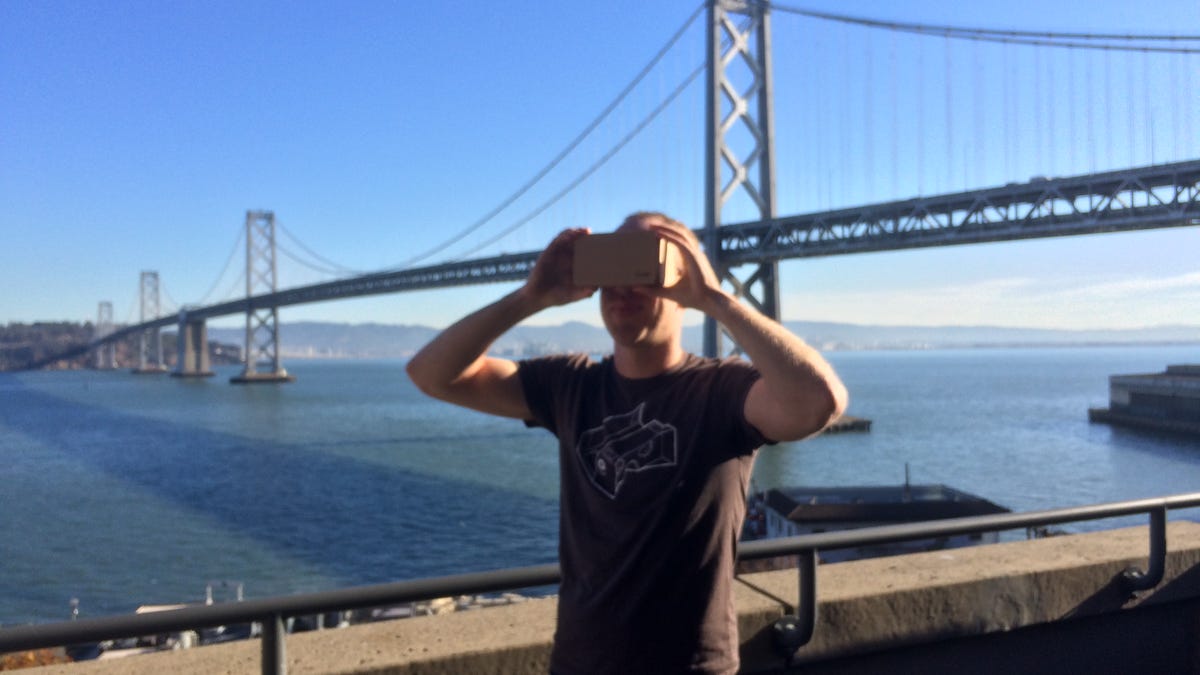Google's next push: Virtual reality in your pocket
The search giant is on a mission to bring VR to the masses. The next step? A smartphone app that lets people take 3D, VR-ready pictures.

Google is making its next push in virtual reality.
I'm standing on a balcony in San Francisco's SoMa neighborhood with a sweeping view of the Bay Bridge, and I have to crane my neck to take in the whole view.
It's a stunning sight that the employees at Google's offices here see often. The search giant now wants to make moments like this accessible to everyone, and it's decided that taking a mere photograph is not enough.
So the company on Thursday launched a new virtual-reality camera app for smartphones that are powered by its Android mobile software. The app lets you take a 3D panoramic photo that you can view in Cardboard, Google's no-frills virtual-reality headset made of, well, cardboard.
You pop your phone into the boxy headset, and once you hold it up to your eyes, you can view the entire scene as if you're there, looking around and behind you. (But not up and down. Google said it's still working on making the experience even more "immersive.")
"It's a really powerful way to understand a moment in time," said Mike Podwal, a product manager for Mountain View, California-based Google.
Virtual reality has become the next frontier for Silicon Valley. Tech giants from Facebook to Samsung are reimagining VR, once mostly the dream of video game makers, as an everyday experience that could include virtual museum tours or visits to farflung doctors.
That's one of the reasons Facebook bought VR goggle maker Oculus for $2 billion last year. It's also why Oculus teamed up with Samsung to create the Gear VR, a $99 headset that uses Samsung phones as screens. Cardboard is much cheaper, with units costing around $25. Google doesn't sell the headsets itself, but makes the plans available to outside vendors.
Google is releasing an Android app that lets people take virtual-reality photos.
For virtual reality to pick up steam, though, people need to get used to having it in their lives. So Google is trying to create as much VR content as it can. Last month, Google-owned YouTube launched a "Cardboard mode" for its Android app, which allows every video in YouTube's massive library to be viewed through the headset. Even content not shot in VR becomes more immersive using Cardboard.
The company has already partnered with action-cam maker GoPro to make Jump, which lets people create professional VR videos with a 16-camera, $15,000 rig. Smartphones are, of course, much cheaper and less complicated. The idea is to get people comfortable with shooting in VR, a future that Google would very much like to provide.
"It helps make VR personal," Podwal said. He gave an example of using the app to capture your childhood bedroom one last time before before your parents sell the house.
Here's how the app works: You hold your phone in front of you, and slowly turn in a circle to film the scene all around you. On average, it takes about 30 seconds to film, said Podwal. Then the app converts the image into 3D. By my count, the processing work takes about 15 seconds. Among the demos for the app are shots from a boardwalk in Santa Cruz, California, and from Mount Kilimanjaro.
For now, the camera app is only available for Android phones, but Google is "looking into" bringing it to Apple's iPhones, according to Podwal. There is also no way to share the VR photos easily with other people yet, but Podwal said the team is working on that too.

